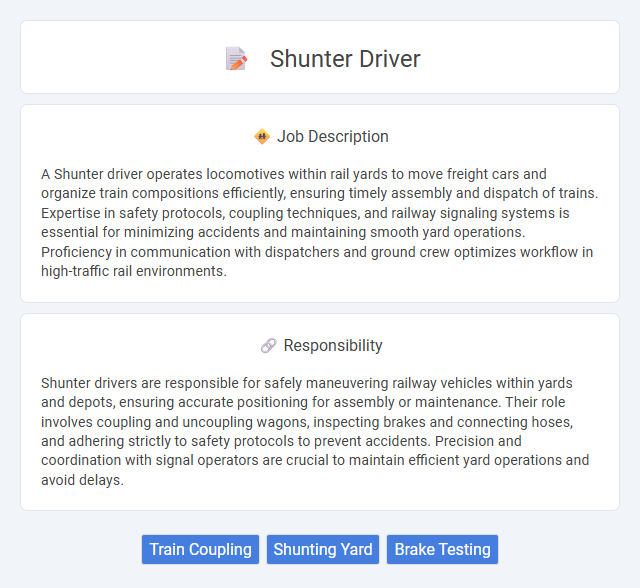
A Shunter driver operates locomotives within rail yards to move freight cars and organize train compositions efficiently, ensuring timely assembly and dispatch of trains. Expertise in safety protocols, coupling techniques, and railway signaling systems is essential for minimizing accidents and maintaining smooth yard operations. Proficiency in communication with dispatchers and ground crew optimizes workflow in high-traffic rail environments.
Individuals with strong attention to detail and good spatial awareness are likely to find the shunter driver role suitable. Those who can remain calm under pressure and have a steady hand may have a higher probability of thriving in this environment. People who prefer routine tasks and are comfortable working outdoors in varying weather conditions might be well-suited for this occupation.
Qualification
Shunter drivers typically require a valid railway safety certification and specialized training in locomotive operation and coupling procedures. Candidates must have a high school diploma or equivalent, with strong mechanical aptitude and attention to safety protocols. Experience in rail yard operations and knowledge of signaling systems enhance job performance and career advancement opportunities.
Responsibility
Shunter drivers are responsible for safely maneuvering railway vehicles within yards and depots, ensuring accurate positioning for assembly or maintenance. Their role involves coupling and uncoupling wagons, inspecting brakes and connecting hoses, and adhering strictly to safety protocols to prevent accidents. Precision and coordination with signal operators are crucial to maintain efficient yard operations and avoid delays.
Benefit
Working as a shunter driver probably offers competitive wages and opportunities for overtime pay due to the demanding nature of the job. Benefits may include health insurance, retirement plans, and paid leave, which contribute to overall job security. There is likely a chance to develop specialized skills that can enhance career advancement within the rail industry.
Challenge
The role of a shunter driver likely presents significant challenges due to the need for precise maneuvering of rail vehicles within congested yards and limited visibility. Navigating tight schedules and coordinating with multiple teams probably increases the complexity, requiring sharp attention to detail and quick decision-making. It is probable that adapting to unexpected obstacles or mechanical issues further tests the skills and resilience of a shunter driver.
Career Advancement
Shunter driver roles serve as a crucial entry point into the rail industry, offering hands-on experience with train maneuvering and yard operations. Mastery in this position enables progression to train driver apprenticeships or logistics coordinator roles, leveraging their deep understanding of rail infrastructure and safety protocols. With proven expertise and certifications, shunter drivers can advance to senior operational positions, enhancing career growth within railway companies.
Key Terms
Train Coupling
Shunter drivers specialize in train coupling, expertly connecting and disconnecting rail cars to form complete train sets for seamless operation. Their role demands precision in aligning couplers, ensuring secure mechanical and pneumatic connections to maintain safety and efficiency in rail yard operations. Mastery of coupling techniques minimizes downtime and supports smooth logistical workflows in freight and passenger rail services.
Shunting Yard
A Shunter driver specializes in organizing and moving railway cars within a shunting yard to ensure efficient train assembly and distribution. Operating locomotives, they maneuver wagons for loading, unloading, and maintenance, prioritizing safety and precision. Mastery of yard layouts and signaling systems is essential for optimizing workflow and minimizing delays in complex rail networks.
Brake Testing
Shunter drivers are responsible for moving and coupling rail cars within yards, requiring expert knowledge in brake testing to ensure safety. Brake testing involves inspecting and verifying the functionality of air brakes, hand brakes, and emergency brakes on locomotives and wagons before movement. Proper brake testing reduces the risk of accidents and ensures compliance with railway safety regulations.
 kuljobs.com
kuljobs.com